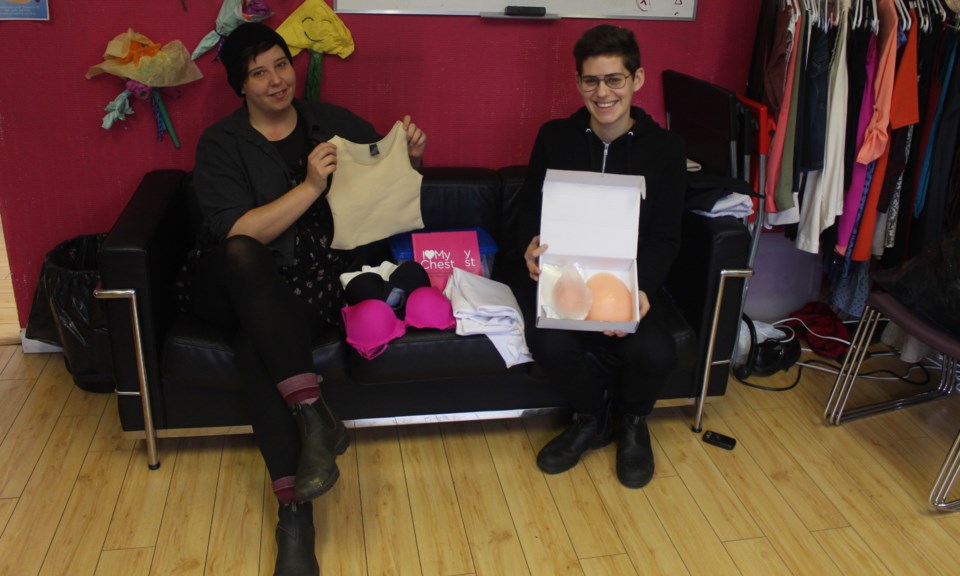For trans and gender variant youth, access to gender-affirming gear or chest wear has a huge impact, says Qmunity youth worker Molly Billows.
“The BBB program can really be life-changing for youth,” Billows says, referring to the Bras, Binders and Breast Forms program they coordinate through the LGBTQ+ community centre in the West End. “You see it with so many youth who come in and go to try on a binder... and come out and [are] still wearing it and are like, ‘Do I have to take it off?’”
A binder is a specially designed, tight-fitting undershirt that compresses a person’s breasts, giving them the appearance of a flatter chest. Along with breast forms, usually made of silicone, these products fall into the category of chest wear.
“You can just tell that maybe it’s the first time that they’re feeling comfortable in the clothes that they’re wearing,” Billows continues, “or, seeing a reflection of themselves [in the mirror], the way they want themselves to look.”
“On the flip side it can be a very devastating experience when we don’t have a garment that fits a youth, or a garment that matches with what they’re looking for.”
The BBB program runs year-round and provides chest wear, free of charge and with no questions asked, to youth in need around the province. Billows and their co-worker, Esther McPhee, say they help 10 to 20 youth access chest wear each month, either by mail or out of Qmunity’s Bute Street office.
Qmunity, which hosts the BBB program, receives funding from corporate and government grants as well as private donors. Billows and McPhee have a small budget with which they make bulk orders every year, but, to meet the demand, they also rely on community members donating new or lightly used chest gear.
Finding the courage to reach out for support can be tough for youth, and that’s why Billows says it’s important to have enough gear on hand.
“It takes a lot of courage to walk in that door for the first time, and so, to turn them away at that point, without being able to give them something, is a devastating moment. I wish we just had enough to give everyone who was seeking [chest wear].”
While the province covers certain health services for trans people – such as gender-affirming surgery – chest wear is not included. Westender reached out to the provincial government and asked why this is.
In a statement, the Ministry of Health said “Chest binders and breast forms are not eligible for coverage under PharmaCare. This is not a reflection of the value of these devices, but rather a reflection of PharmaCare’s ability to cover such items within the limits of available funding. PharmaCare coverage of devices is limited to permanent prosthetic appliances and children’s orthotic braces.”
Steve Morgan, professor at UBC’s School of Population and Public Health, says the fact that the province does not cover chest wear is part of a larger issue in health insurance coverage. “Canadians may be surprised to realize that our health care system is not nearly as comprehensive as originally planned,” he says. Medical services, hospital care, dental care, pharmaceuticals, home-care and medical devices were originally in the federal government’s plans after the Second World War, but, after negotiations broke down between the federal government and the provinces, it was decided that universal health care would be rolled out in stages.
As a “consequence of moving slowly,” the various governments only established coverage of hospital and physician services, Morgan says. “We didn’t see any other stage of Medicare be developed at a national level… so Canadians actually go without universal public coverage for a number of things that would be routinely publicly covered in comparable health systems abroad.”
Coverage of medical devices (the category that chest wear would fall into) varies by province, and Morgan says the fact that they aren’t covered in B.C. doesn’t necessarily equate to a disregard for trans health. Many different population groups go without coverage for necessary or preventative medical devices or services, he says.
However, Billows says the question of why chest wear isn’t covered is “part of a wider conversation about why care for trans folk and trans youth isn’t more widely available or easily available in general.”
• To donate items to Qmunity’s BBB program, contact youth@qmunity.ca.



